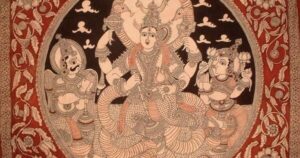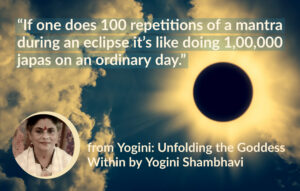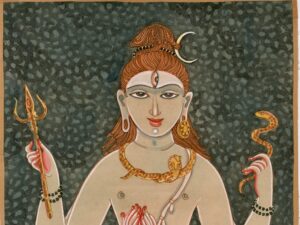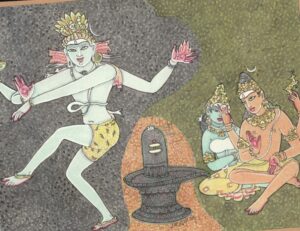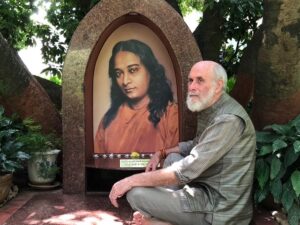By David Frawley (Pandit Vamadeva Shastri)
In the following article we will discuss the Vedic principle of Soma and its related principle of Agni in order to help us understand the internal alchemy behind the deeper practices of Yoga and Ayurveda.
Soma and Ananda
The Vedic ritual reaches its climax in the Soma offering, in which specially prepared plant juices are offered into the sacred fire (Agni) as the drink of the Devas. But this ancient ritual reflects a deeper internal ritual or alchemy of awareness that is its real import. In exploring this process, we will discover many secrets of the practice of Yoga.
Soma is first of all part of a great universal symbolism. Soma pervades the outer world as water in its various forms on the earth and in the sky, as the sap of plants, the vital fluids in animals, the Moon, and even the waters (vibratory field) of space. Soma exists inside ourselves as a psychological principle of feeling, love and inspiration, including as our creativity that we manifest in diverse forms.
Yet beyond this, Soma is a spiritual principle, an aspect of the infinite and a key to immortality. In the state of meditation, the brain and mind naturally secrete a special type of Soma or nectar of peace and contentment, which reflects this spiritual Soma. Ultimately Soma is the bliss of all existence, the Ananda through which the universe is created and into which it must return. It is this Soma or Ananda that is the prima materia or ultimate substance behind the entire world.
Soma and Agni: Bliss and Consciousness
To understand Soma, we must understand Agni, the fire, light or energy principle, which is its counterpart. In Vedic thought, the twin principles of Agni and Soma are behind all workings in the universe on all levels. On an outer level, they refer to the great elements of fire and water, but their inner symbolism goes much deeper. Such a twofold division of reality takes many forms like Purusha and Prakriti, Vishnu and Lakshmi, and Shiva and Shakti. Indeed, Lord Shiva, the supreme Godhead, is said to be Agni-Somatmakam or both Agni and Soma in nature. His right side is Agni in nature–fiery, harsh or masculine. His left side is Soma in nature– watery, gentle or feminine. These are the basis of his two manifestations as fierce (ghora or Agni) and gentle (saumya or Soma).
Agni as fire represents light (Jyoti) in the broadest sense, which includes the light of perception and the light of consciousness, not simply light as a material principle. Soma as water (Apas) is the medium on which light can be reflected, which is ultimately a quality of light itself. In this regard Soma is not only water, but the mind and ultimately, the reflective power of consciousness itself.
Soma as a cosmic power is not simply watery in its nature. It has an oily quality that can nourish and sustain fire. It has been compared to ghee (ghrita) in texture. All objects that we see are like fuel for the flame of our awareness. Soma also has a sweet quality and has been compared to honey (madhu). All that we see is like a flower, from which the honey of bliss can be extracted. These properties that can sustain light and provide joy pervade all of space. Great yogis can access them with their subtle bodies (the linga or fire body) and move at will through all the worlds, finding nourishment and delight in all that they perceive.
Soma is the delight which is the counterpart of light. On the deepest level, Agni is the fire of consciousness (Chidagni) that is reflected in the Soma or water of bliss. In this regard Agni and Soma are ultimately the same, two complementary aspects of Brahman.
Objectless Delight
The highest Soma is the delight inherent in existence itself (Brahman), not simply the pleasure produced by contact with external objects. Soma is the ‘pure delight’ that we are truly seeking in all that we pursue, not mere temporary pleasure that wears away the senses and is only its reflection. Any happiness that is based upon contact with an external object must be fleeting and must eventually end in pain. This higher ‘objectless’ joy or self-delight can only be perceived by an internal consciousness beyond the fluctuations of the mind, by the unwavering flame of awareness. We can achieve that through taking the state of the witness (sakshi-bhava), which provides the joy of perception and avoids the pain of involvement. As long as we rely on external contacts to gain our Soma or happiness, we cannot escape from the wheel of sorrow.
We are all seeking some form of happiness in life. We all want lasting bliss. This seeking of Soma is inherent in the soul, which is ever seeking to return to its origin in God. Similarly, we are always extracting some form of Soma out of our life experience. This essence or rasa is ultimately delight. That is why the Upanishads refer to the Self as rasa (raso vai sah).
The Self is said to be the fluidity of water, the heat of fire, the power of the wind to move, the power of the earth to hold and the power of space to pervade. It is the unique quality or special essence, what is the highest and best in all things. This unique essence is Soma. We discover the Self by going to the essence of our own nature. The Self is the eye of the eye, the ear of the ear, the mind of the mind. It is the truth of truth. This extraction of the essence from all that we know is extracting the Soma that is hidden in all things. This extraction process occurs in the purification filter (pavitra) of the heart, by the light of which we can discern the heart or core of all things.
The Seer and the Seen
Relative to the Yoga of Knowledge (Jnana Yoga), Agni is the seer and Soma is the seen. Seeing has a fiery quality and works through light. The seen is the field illumined by light and is actually only light or consciousness reflected externally. Our very power of seeing is a power of fire while all that we see is potentially fuel for it. If our seeing is clear then it can disclose the Soma or Ananda hidden in all that we see. The fire of seeing is able to ripen, cook or bring out the essence of all that we observe. The key to the alchemy of Jnana (Self-knowledge) is that whatever we look at with full attention, with a fully energized Agni or fire of awareness, will yield Soma or delight, not as an external enjoyment but as the very bliss of the Self.
When we look at things directly, without division, their essence comes forth, which is Ananda. This is the state of Samadhi, which is the flowing of Soma at an inner level. The unity of Agni and Soma is the unity of the perceiver and the perceived. When we learn to look at our inner self wholly and fully, through the practice of Self-inquiry, then the delight inherent in the Self must come forth as the ultimate Soma or self-delight.
Soma and the Five Koshas
The five sheaths or koshas are a common yogic teaching going back to the Taittiriya Upanishad. Each of these five levels of our nature has its own form of Agni or fire, which is its essential energy. Each has its equivalent form of Soma, which is its main fuel. Agni is the eater or enjoyer, while Soma is the food or substance enjoyed.
- At the physical level (Annamaya kosha), the digestive fire (Jathargni) is the Agni, and the food and drink we take in through the mouth is the Soma. Higher physical forms of Soma include special rejuvenating foods, beverages and herbs that can revitalize the body, brain and nervous system.
- At the pranic or vital level (Pranamaya kosha), Pranagni or the vital fire is the Agni and our vital enjoyments of exercise and activity are the Soma. Higher Pranic forms of Soma including Pranayama practices that can revitalize our internal Pranas and balance their energies towards transformation.
- At the level of the outer or sensory mind (Manomaya kosha), the mental fire (Manasika Agni) is the Agni and our various sensory enjoyments are the Soma. Higher mental forms of Soma include mantra, visualizations and meditations that bring in a higher level of experience into the mind.
- At the level of the inner or discriminating mind (Vijnanamaya Kosha), the Buddhi or discriminating intelligence is the Agni and the various principles, beliefs, ideas or dharmas that we pursue in life are the Soma. Special types of Soma for the higher mind include formless meditations on truth, unity, bliss and harmony.
- At the level of the soul (Jiva or Anandamaya kosha), our inner consciousness (Chitta) is the Agni, and our entire life experiences and memories are the Soma. Special types of Soma for it include the practice of Self-inquiry in which we digest our life-experiences, burning up our Samskaras (internal karmic tendencies) and turn them into pure awareness.
In this way, the soul or Jiva takes in substances, impressions and ideas from the external world and extracts the nectar of Ananda from them, just as a bee gathers pollen from various flowers and turns them into honey. The ultimate result is the essence (rasa) of our experience that becomes the Ananda or Soma Kosha, in which our karmas and samskaras are held. Those who have cultivated the fire of awareness are able to turn all their experience, including that of sorrow, into Soma or Ananda. This takes them beyond the field of all the Koshas.
Agni and Soma and the Practice of Yoga
In the practice of Yoga, Agni is the fiery Kundalini force that dwells in the root or earth chakra below. It is the power of aspiration that rises from below and ascends to the heavens above. Soma is the watery nectar that dwells in the crown or head chakra. It is the power of Divine grace that descends from above. As Agni rises, Soma descends. The oily drops of Soma provide the fuel for Agni to aid in its upward movement.
The Yoga tradition teaches us that the crown chakra is the region of the Moon or Soma (Chandra Kanda), just as the lower three chakras are the region of fire (Agni-Kanda). Soma, according to the Vedas, flows in a thousand streams. These are the thousand currents of the crown chakra, the Sahasrara or thousand petalled lotus. Physiologically, Agni relates to the solar plexus, while Soma relates to the soft palate in the head, the source of saliva and other secretions in the head. Balancing these two energy centers is an important Yoga practice.
Self-inquiry and Surrender
Agni is the striving of the soul upward towards the divine, while Soma represents the descending Divine grace. Agni represents our will or aspiration to the truth, while Soma represents what inspires us and the goal that we seek. That is why Agni or fire is represented by an upward facing triangle, while water or Soma is represented by a triangle that faces downward.
Agni represents Jnana Yoga or the Yoga of Knowledge, which proceeds through the heat and friction of introspection and self-inquiry. This is the main upward movement of the soul. Similarly, Soma represents Bhakti Yoga or the Yoga of Devotion, which proceeds through the flow of surrender. This is the main descending movement of grace.
Self-inquiry (Jnana Yoga) is the best, simplest and most direct method for cultivating our inner fire and reaching the supreme light. Surrender to God or devotion (Bhakti Yoga) is the best, simplest and most direct method for opening up to the flow of grace and reaching the highest delight.
The practice of meditation should always strive to be a dual cultivation of both Agni and Soma, with both deepening perception and joy. A balanced practice should address both Agni and Soma aspects of the practice. Cultivating Agni means cultivating the flame of our awareness, concentration, perception and discrimination. It means increasing the power of the mind to inquire, perceive, penetrate and transform.
In this regard there is a helpful metaphor: The mind is like a wick. Knowledge (Jnana) is like the flame, but Devotion (Bhakti) is the oil (ghee). Without the oil to sustain the flame, it will merely burn up the wick. So too, a mind that does not have that flow of grace or devotion, can be burned up or dried out by the flame of knowledge. We should must remember to keep our Soma flowing.

